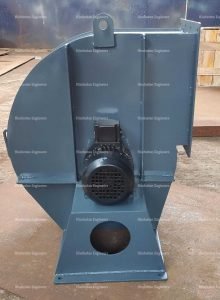Centrifugal Fan

Centrifugal fans consist of an impeller in a casing having a spirally shaped contour. The air enters the impeller in an axial direction and is discharged at the impeller outer periphery. The air flow moves along the centrifugal direction (or radial direction). Sometimes centrifugal fans are called radial flow type fans. Centrifugal fans are capable of generating relatively high pressures. They are suitable for high pressure applications as compared with axial flow fans. Generally centrifugal fans have three types of blade: forward blade, backward blade and radial blade.
Main parts of a centrifugal fan are :
*Fan housing
*Impellers
*Inlet and outlet ducts
*Drive shaft
*Drive mechanism

Fan blades
The fan wheel consists of a hub with a number of fan blades attached. The fan blades on the hub can be arranged in three different ways: forward-curved, backward-curved or radial.
Forward-curved
Forward-curved blades, curve in the direction of the fan wheel’s rotation. These are especially sensitive to particulates and commonly are only specified for clean-air applications such as air conditioning. Forward-curved blades provide a low noise level and relatively small air flow with a high increase in static pressure.
Backward-curved
Backward-curved blades, curve against the direction of the fan wheel’s rotation. Smaller blowers may have backward-inclined blades, which are straight, not curved. Larger backward-inclined/-curved blowers have blades whose backward curvatures mimic that of an airfoil cross section, but both designs provide good operating efficiency with relatively economical construction techniques. These types of blowers are designed to handle gas streams with low to moderate particulate loadings. They can be easily fitted with wear protection but certain blade curvatures can be prone to solids build-up. Backward curved wheels are often heavier than corresponding forward-curved equivalents, as they run at higher speeds and require stronger construction. Backward curved fans can have a high range of specific speeds but are most often used for medium specific speed applications—high pressure, medium flow applications. Backward-curved fans are much more energy efficient than radial blade fans and so, for high power applications may be a suitable alternative to the lower cost radial bladed fan.
Straight radial
Radial blowers, have wheels whose blades extend straight out from the centre of the hub. Radial bladed wheels are often used on particulate-laden gas streams because they are the least sensitive to solid build-up on the blades, but they are often characterized by greater noise output. High speeds, low volumes, and high pressures are common with radial blowers[citation
needed], and are often used in vacuum cleaners, pneumatic material conveying systems, and similar processes.
Impeller entry
Flow at the intake and its turning from axial to radial direction causes losses at the intake. Friction and flow separation cause impeller blade losses since there is change in incidence angle. These impeller blade losses are also included in the category.
We manufacture a range of centrifugal fans that are widely used in various industries for moving air or gases. Designed with precision using graded components, our rage of centrifugal fans are widely appreciated for their high efficiency, low energy consumption and long functional life. These fans are also quality tested by us on various parameters to meet the set industrial standards.
SS Blower

